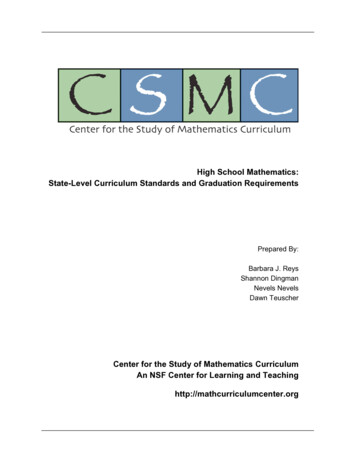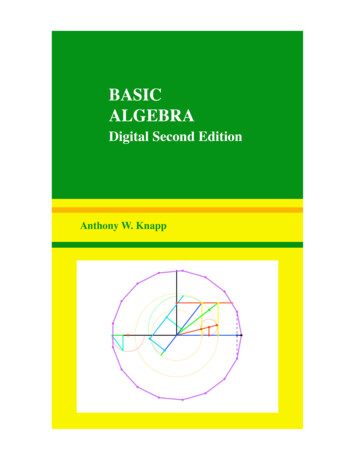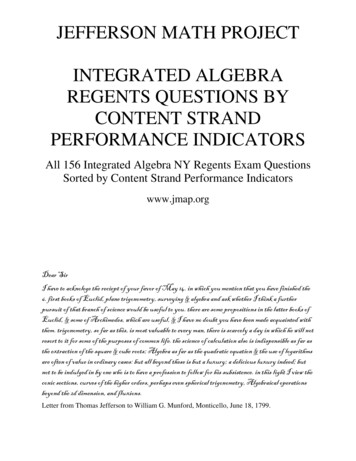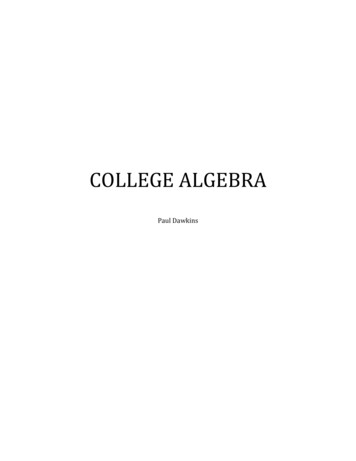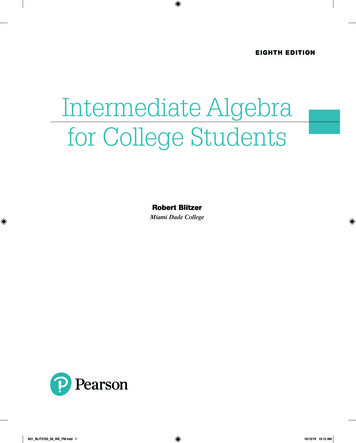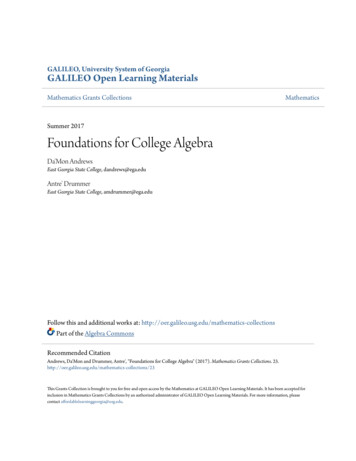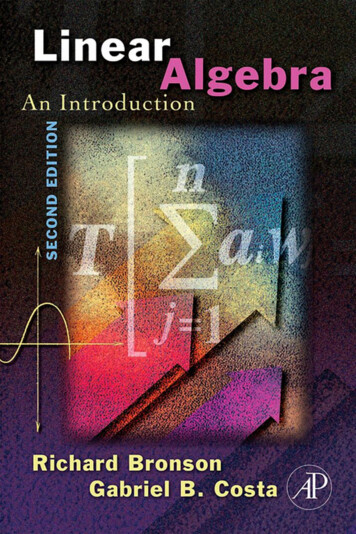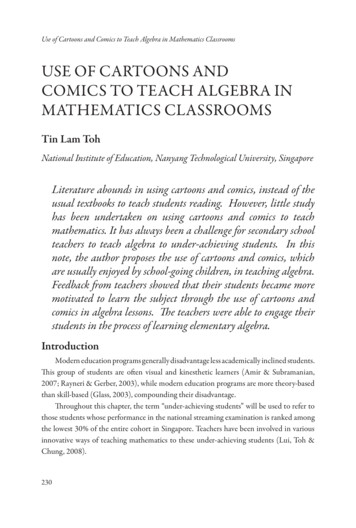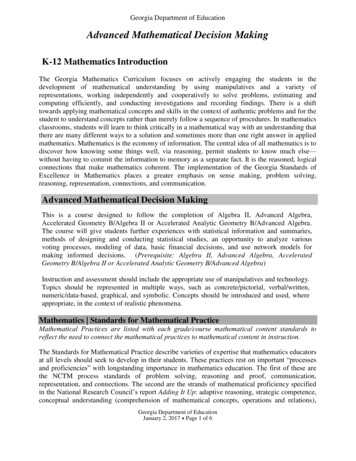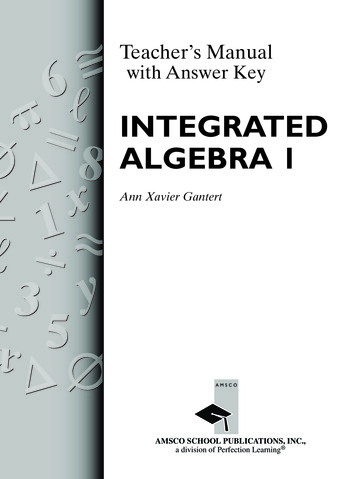
Transcription
Teacher’s Manualwith Answer KeyINTEGRATEDALGEBRA 1Ann Xavier GantertAMSCOAMSCO ., 315 HUDSONSTREET,NEW YORK,N.Y. 10013a divisionof PerfectionLearning
14271FM.pgs9/25/0610:54 AMPage ivContentsAnswer KeysFor Enrichment Activities264For Suggested Test Items280For SAT Preparation Exercises288For Textbook ExercisesChapter 1290Chapter 2293Chapter 3299Chapter 4303Chapter 5308Chapter 6312Chapter 7315Chapter 8321Chapter 9324Chapter 10345Chapter 11355Chapter 12358Chapter 13362Chapter 14371Chapter 15375Chapter 16384
14271AKEA.pgs9/25/0610:37 AMPage 264Answers for Enrichment Activity ExercisesEnrichment Activity 1-1: Guessing aNumber by BisectionTo find a word in the dictionary, choose a middleword alphabetically and ask if the chosen wordcomes before or after the word for which you aresearching. Continue the process. To find a nameon a list, choose a middle name and continue theprocess.a. 8b. 6c. A maximum of 11 guesses would be needed tolocate a number between 1 and 2,000. The firstguess would be the average of 0 and 2,000, or1,000. Assuming that the number itself was not1,000, this would divide the possible numbersinto two equal sets: numbers between 0 and 999and numbers between 1,001 and 2,000. Sets ofthis size require a maximum of 10 guesses tofind the number.Enrichment Activity 1-2: RepeatingDecimals73. 125.Use a simpler related problem to find a generalsolution.2From 1 to 73From 1 to 154RangeMax. Numberof Numbers of GuessesFrom 1 to 3From 1 to 7From 1 to 15From 1 to 31From 1 to 63From 1 to 127From 1 to 2552345678471117. 19. 15RangeMax. Numberof Numbers of GuessesFrom 1 to 32. 419911. 154. 1033256. 32299 or 3998. 15519810. 120Enrichment Activity 1-3: A Piece of PiFirst guess would be 2.If 2 is not the number,the next guess wouldbe correct.First guess would be 4.If 4 is not the number,the number must beone of a set of threepossible numbers, andat most two moreguesses are needed.First guess would be 8.If 8 is not the number,the number must beone of a set of sevenpossible numbers, andat most three moreguesses are needed.1. 0 111 52 123 114 105 86 97 88 129 142. No. The digit 9 appears most often while the digit1 appears least often.3. 0 121 112 123 84 125 126 77 48 139 94. Answers will vary. Example: The digits 0, 1, 4, 5,and 8 appear more often than in the first group,the digits 3, 6, 7, and 9 appear less often than inthe first group, and the digit 8 appears with samefrequency as in the first group.5. 0 231 162 243 194 225 206 167 128 259 236. Answers will vary. Examples: The digit 7 appearssignificantly less frequently than the other digits.Appearances of the digits 0, 2, 3, 4, 5, 8, and 9 areevening out. As more digits in the expansion arechecked, the digits may seem to appear the samenumber of times.Powers of 2Enrichment Activity 1-4: Making 10022 423 824 1625 3226 6427 12828 2562,1481,7521. 96 5371,4283. 96 3572. 96 4381,5784. 94 2635. 91 8363,5467. 82 1976. 91 6477,5248. 81 3967,5245,6435,82369,2589. 81 29710. 3 7145,47211. Answers will vary. Examples: 13 5 9 1,368,5,1483,57616 5 12 894 , 40 5 27 396If 2n 1 the number of integers in the setfrom which the chosen number is selected,n is the maximum number of guesses needed toidentify the number.264
9/25/0610:37 AMPage 265Enrichment Activity 2-1: Special Ops3.58581.4.7.10.12.72. 56.25. 200.48. 75811. 14a. a b a 2bb. 413. Answers will vary.3.6.9. 23 12345678123456789 10 11 12 123456789 10 11 12 13456789 10 11 12 1456789 10 11 12 19 10 11 12 19 10 11 ment Activity 2-5: Paying the Toll4561(7) 2( 3) 11(11) 112345671(11) 3( 3) 24(3) 122(11) 2223456781(3) 31(7) 2(3) 132(7) 3(3) 231(7) 1( 3) 41(11) 1(3) 148(3) 2491(11) 2( 3) 55(3) 152(11) 1(3) 252(3) 61(7) 3(3) 163(11) 1( 7) 261(7) 71(11) 2(3) 179(3) 271(11) 1( 3) 81(11) 1(7) 184(7) 283(3) 91(7) 4(3) 192(11) 1(7) 291(7) 1(3) 102(7) 2(3) 203(7) 3(3) 3078789 10 11 12 1789 10 11 12 189 10 11 12 1234567810 11 12 123456789 1011 12 123456789 10 1112 13456789 10 11 12YesYesYes12Number 1 2 3 4 5 6 7 8 9 10 11 12Enrichment Activity 2-8: GraphingOrdered Pairs of NumbersEnrichment Activity 2-2B: Digital Addition;Digital 1(11) 1(7) 1(3) 21All purchases can be made since any wholenumber can be formed using multiples of thenumbers above.Inverse 11 10 9 8 7 6 5 4 3 2 1 121.43669 10 11 12 1b. 1.2.3.4.5.225204. a. Yesb. Yesc. Yesd. 6e. Number z Inverse Identity2z8 64z6 66z4 68z2 65. YesConclusion: This is a field; all 11 properties hold.Enrichment Activity 2-2A: Clock Arithmetica.za.HAGState Street14271AKEA.pgsLCVOMPSMain StreetFD2. a. Yesb. Yesc. Yesd. 0e. Number { Inverse Identity0{0 02{8 04{6 06{4 08{2 0b. M is two blocks west and one block south ofO( 2, 1).c. The first number gives the number of blocks eastor west of O, the center of town. If the number ispositive, the position is east of O; if the numberis negative, the position is west of O. The secondnumber gives the number of blocks north or265
14271AKEA.pgs9/25/0610:37 AMPage 266south of O. If the number is positive, the positionis north of O; if the number is negative, theposition is south of O.4.6.8.9.16x 13,600 5. x 150; x 300; x 45016x 20,400 7. 33x 34,00033x 34,000 65,000 3,00010. 3,50011. 45,200Enrichment Activity 3-1: Number PlayEnrichment Activity 4-3: ConsecutiveIntegersColumns 2 and 3 will vary. The answers for columns 1and 4 are shown below.Col. 11.2.3.4.5.6.7.8.9.1.Col. 4153383,8003,6003604002015n2n2n 8200n 800200n 60020n 6020n 100n 5nNumberof IntegersFirstIntegerSumEvenor Odd316even3415odd3724even3x3x 3even or odd4110even4422even4734evenConclusion: The result on line 9 will always equal thestarting number on line 1.4x4x 6even5115oddEnrichment Activity 3-2: Variable Codes5430even5745odd5x5x 10even or odd6121odd6439odd6757odd6x6x 15odd7128even7449odd7770even7x7x 21even or odd1. a. PAOIKb. ZUSUXXUCc. SGZNKSGZOIYd. KDZXGUXJOTGXE2. Answers will vary.3. I MUST STUDY FOR AN EXAM4. a. XIVRKb. GLQQCVc. RJJZXEDVEKd. VOGCFIRKZFE5. x 96. NZIXS, MLEVNYVI; the correspondence issymmetric. If a line is drawn between M and N inthe alphabet list, the corresponding letters areequal distances from that line. A corresponds toZ, B corresponds to Y, and so on.7. a. MLBNCFHb. TUESDAY; the result is the original word.7 x is the encoding and decoding expression.8. a. YKBWTRb. RDUPMK; no2. Let x be the first consecutive integer.a. Odd; 2x 1 is the sum of an even number andan odd number.b. Even when x is odd; 3x 3 is the sum of twoodd numbers.Odd when x is even; 3x 3 is the sum of aneven number and an odd number.c. Even; 4x 6 is the sum of two even numbers.d. Even when x is even; 5x 10 is the sum oftwo even numbers.Odd when x is odd; 5x 10 is the sum of anodd number and an even number.e. Odd; 6x 15 is the sum of an even numberand an odd number.f. Even when x is odd; 7x 21 is the sum of twoodd numbers.Odd when x is even; 7x 21 is the sum of aneven number and an odd number.Enrichment Activity 3-7: Formulas forHealth1.4.7.10.13.22 31 24 114 bpm19 bpm2.5.8.11.14.24 26 34 19 bpm84%3.6.9.12.17 22 BMI 5 703W2H23 bpmEnrichment Activity 4-2: Book Value1. Let x represent the middle book because thevalues of the other books can be expressed inrelation to it.2. 16 books3. x 100; x 200; x 300266
14271AKEA.pgs3.4.5.6.9/25/0610:37 AMPage 2672. x 4g. Even when the number of integers divided by2 is even.Odd when the number of integers divided by2 is odd.h. Even when the first integer is even and thenumber of integers after the first, divided by 2,is even.Odd when the first integer is odd and thenumber of integers after the first, divided by 2,is even.Even when the first integer is odd and thenumber of integers after the first, divided by 2,is odd.Odd when the first integer is even and thenumber of integers after the first, divided by 2,is odd.a. 3b. 5c. 7d. The sum always has the number of consecutiveintegers as a factor. The sum is always thenumber of integers times the middle number.a. Nob. The sum is 6 more than 4 times the first integer.The sum is twice the sum of the second andthird integers.The sum is 6 less than 4 times the last integer.a. Student tablesb. The sum of even integers is always even.a. Student tablesb. The sum of odd integers is even if there is aneven number of integers and odd if there is anodd number of integers.3. x 34.All real numbersbetween 4 and4; [ 4, 4]5.All real numbersbetween 1 and1; ( 1, 1)6.All real numbersgreater than 1;(1, ). Since thereis no real numberthat is the squareroot of a negative number, theinequality is meaningless for x 0.Enrichment Activity 4-4: Law of the Lever1.2.3.4.5.2.4 ft15 lb, 25 lbHeavier carton, 9 ft; lighter carton, 12 ftKelly, 49 lb; Laurie, 70 lba. The side with the 32-lb weightb. 3 ftEnrichment Activity 4-7: Graphing anInequality1. x 4267
14271AKEA.pgs9/25/0610:37 AM7.Page 268Enrichment Activity 5-2: An Odd TriangleAll real numbers;( , ).8.1. Row 6: 31, 33, 35, 37, 39, 41Row 7: 43, 45, 47, 49, 51, 53, 552. 1, 9, 25, 49; the middle number in odd-numberedRow n is n2.3. 4, 16, 36; the average of the middle numbers ineven-numbered Row n is n2.4. a. 169b. 6c. 157, 159, 161, 163, 165, 167, 169, 171, 173, 175,179, 181, 183All positive realnumbers; (0, ).5. Row NumberSince x is alwayspositive, there isno real numberthat makes thisinequality true; .9.10. a.42 4 5 25 522.n 1n n (n 1) n 2n 12nn2n2?(n2 2n 1) 5 (n 1)2b.? 1n 111283274645125621673436. Sum of the numbers in Row n n37. a. 1,728b. Row 198. a. 3 22 1, 7 32 2, 13 42 3,21 52 4, 31 62 5, 43 72 6b. n2 (n 1) n2 n 19. a. 5 22 1, 11 32 2, 19 42 3,29 52 4, 41 62 5, 55 72 6b. n2 (n 1) n2 n 1Enrichment Activity 5-1: Sums and Squares1.Sum of Numbers in Rown2 2n 1 5 (n 1)(n 1)n2 2n 1 n2 2n 1n2 2n 1 (n 1)2CRowNumberSum of AllNumbersSum Writtenas a Square11122932336624100102522515264412127784282n(n 1 1) 2D2Enrichment Activity 5-4: Products, Sums,and Cubes3. 202 20 21 400 20 21 4414. 102 1005. (n 1)21. 3(4)(5) 4 60 4 64 434(5)(6) 5 120 5 125 535(6)(7) 6 210 6 216 632. The product of three consecutive integers plusthe middle integer is equal to the cube of themiddle integer.268
14271AKEA.pgs9/25/0610:37 AMPage 2693. 6(7)(8) 7 336 7 343 734. 7(8)(9) 8 504 8 512 835. (n 1)(n)(n 1) n n(n 1)(n 1) n (n2 n)(n 1) n n3 n2 n2 n n n3Enrichment Activity 6-1B: Ratio: Estimatesand ComparisonsColumns 1 and 2 will vary according to studentestimates.Column 3Actual Ratioof SizeSource for Teacher:Area (sq 1.043,855,101Enrichment Activity 6-1A: FibonacciSequence and the Golden RatioChina1.003,705,405India0.341,269,345Part 1. For clarity, the first 26 terms of the Fibonaccisequence are written below from smallest tolargest in three-column 6,592,769Spain0.05194,897United States1.003,718,709?6. (n)(n 1)(n 2) (n 1) 5 (n 1)3?(n)(n2 3n 2) (n 1) 5 (n 1)(n 1)(n 1)?(n3 3n2 2n) (n 1) 5 (n 1)(n2 2n 1)n3 3n2 3n 1 n3 3n2 3n 1Part 97121,393342,5845 1.6255 1.6190475 1.6185 1.61805 1.618037135 1.618034448 1.618034056 1.618033999 1.61803399 54,18117,71110,94646,36828,657121,39375,025Bonus:5 1.615384 1.617647059 1.617977528 1.618025751 1.618032787 1.618033813 1.618033963Actual Ratioof a1.67Japan0.19Mexico1.00Russia8.66Spain0.26United States4.88In a and b, student responses will vary.a. With Mexico’s area used as the base of comparison, its ratio changes from 0.20 to 1.00. In turn,the ratio for every nation becomes about 5 timesas large as the ratio using the United States asthe base of comparison.b. The ratios in both lists show the sizes of thecountries in relation to one another: Japan hasthe smallest area, followed by Spain, up to Russiawith the largest area. 1.618033985 1.618033988 1.618033989Part 3. 1 12"5 1.618033989As the terms of the Fibonacci sequenceincrease, the ratio comparing the greaterof two consecutive Fibonacci numbers tothe smaller approaches the value of thegolden ratio.269
14271AKEA.pgs9/25/0610:37 AMPage 270Enrichment Activity 6-2: Population Density9. a. Falseb. Leads to the contradiction (y 0)1cc10. ba , ba 1d , dPart 1.StateLand Area PopulationPopulation (sq 1145,5526New Jersey8,638,3967,4141,165New 9261,79784North CarolinaTexasEnrichment Activity 7-4: Hero’s Formula1. a. 24 sq in.b. 24 sq in.2. a. 431.6 m2b. 11,161.36 sq ft3. a. 388.8 cm2b. Since the area and base are known, substitutethe values into the formula A 5 12bh; b 18 cmc. Right triangleEnrichment Activity 7-5: RectangleCover-Up1. 5 waysPart 2. a. Student estimates will vary.b. Canada, 9; China, 361; India, 943;Japan, 880; Mexico, 141; Russia, 22Enrichment Activity 6-3: Catching Up2. 8 ways251. a. 35 stepsb. 5 stepsc. 12.535 or 702. a. 43 stepsb. 5 steps; 10 steps25c. 4325d. 43. 2570 ; Evan is gaining on Marisa.37.575 50 62.5753. 51 or 102, 59, 67 or 125134 , 754. Evan continues to gain on Marisa until hecatches her after he has taken a total of 30 stepsand she has taken a total of 75 steps.Enrichment Activity 6-4: Ratios andInequalities1. Approach 1 proof:abab (b)(d)adadApproach 2 proof:aba dbAdBadbd,,,,,cdcd (b)(d)cd, A bb B dcbc, bdad , bc2. a. ad bcb. ad bcc. d bd. d bc13. b1 . b 1mustbetrue because 1(b 1)1or b 1 b.4. ba . 1 is true because a25.6.7.8.3.cbbcRectangles of Width 2Length of RectangleNumber of Ways toCover with Dominoes0111223345b(1)58b2, so "a . "b and6137218349551089a b.a b is true because a(b c) b(a c), soab ac ba bc and ac bc.a. Falseb. Leads to contradiction (x 0)a. Trueb. Consistent with x 0, y 0a. Falseb. Leads to contradiction (y 0)4. Each number is the sum of the two previousnumbers. This is the Fibonacci sequence.270
14271AKEA.pgs9/25/0610:37 AMPage 271Enrichment Activity 7-6: Area of Polygons221. a. 60 cmb. 12r(ED)4. 12nsr2. a. 480 cmb. 4r(ED)5. a. 9"3 sq in.d. 28,500 cm26. 69, 260, 269 or 69, 92, 115 (Other answers are possible.)7. a. Yes; 6, 8, 10b. No. If a number is odd, its square is odd. Thesum of the squares of two odd numbers is even.Therefore, the third number must be even.c. Yes; 3, 4, 5d. No. If either a or b is odd and the other even,then c must be odd. If a and b are both even,then c must be even. Therefore, it is notpossible to have exactly one odd number in aPythagorean triple.3. a. 88 sq in.b. 52r(YZ)b. 96"3 cm2e. 800 mm2c. 8 m2Enrichment Activity 8-1: Pythagorean Triples1. a.UVU2 V22UVU2 V221345318610411581751241026613512Enrichment Activity 8-3: Polytans1.374 22. a.22UVU V2UVU V325121343724255494041651160617613842224 23. a.64 2 22 3 24 2 22 3 24 2 224 2 24 2 24 2 24 2 24 4 24 4 24 4 24 4 285b. The difference between U V and 2UV is 1.The sum of U2 V2 and 2UV is the square ofU2 V2. The sum of the three numbers is theproduct of U2 V2 and U2 V2 1 [5 12 13 5 6]. The smallest number, U2 V2, isthe sum of U and V. Other relationships arepossible.22 3 22. 4 1 "2, 2 1 3"23.b. The difference between U V and U V 2is 2. The sum of U 2 V 2 and U 2 V 2 is U times2U [5 3 2(4)]. The sum of the three numbers is twice the product of U and the next consecutive integer [3 4 5 2(2 3)]. Otherrelationships are possible.22UVU2 V22UVU2 V2421216205316303464204852752470748628961004. 4"2, 6, 4 1 2"2, 2 1 4"24 4 2Enrichment Activity 8-6: TrigonometricIdentities1. a. 1b. 1c. 1d. 1e. 1f. 12. tan A tan (90 A) 1, where 0 A 90 3. tan A 5 batan B 5 batan A 3 tan B 5 ba 3 ba 5 1B 90 Atan A tan (90 A) 14. a. 1b. 1c. 1d. 1e. 1f. 15. (sin A)2 (cos A)2 126. sin A 5 ac, (sin A) 2 5 A ac B 2 5 ac2b. The difference between U2 V2 and 2UV is 4.The sum of U2 V2 and U2 V2 is twice U2[20 12 2(42)]. The sum of U2 V2 and2UV is the square of half the smallest number,U2 V2 [20 16 (12 2)2]. Other relationships are possible.4. 10 and 75. 33, 56, 65 or 42, 56, 70 (Other answers are possible.)cos A 5 bc, (cos A) 2 5 A bc B 2 5 bc22222b2(sin A) 2 1 (cos A) 2 5 ac2 1 bc2 5 a 15 cc2 5 1c2(Note the use of the Pythagorean Theorem.)2271
sin 428b. cos428 5 tan 428sin 788c. cos788 5 tan 788sin 348d. cos348 5 tan 348sin 158e. cos158 5 tan 158sin 78f. cos78 5 tan 7811.z(0, 0, 4)sin A8. cosA 5 tan A, where 0 A 90 9. sin A 5 accos A 5 bctan A 5 basin Aabacacos A 5 c 4 c 5 c 3 b 5 b 5 tan A1(0, –4, 0)y1(2, 0, 0)1sin 2087. a. cos208 5 tan 208Enrichment Activity 9-3: Graphing withThree Variables1–4.xz(2, –5, 7)(3, 2, 6)Enrichment Activity 9-7: Iterating LinearFunctionsStarting Value 5y11x(5, –4, 1)5. Octant 68. Octant 810.y 0.4x 61.1(4, 2, –3)z(0, 0, 4)1y1(0, 3, 5210.020482. The iterates are approaching 10; for the startingvalue 5, the iterates approach 10 from below;for the starting value 15, the iterates approach10 from above.3. All the y-values (outputs) are exactly 10.4. a. 3b. 4c. 0d. 25. y x6. a. x 5 1 2b mb. Undefined for m 1 since the denominatorwould be 0. Functions of the form y x b(b 0) cannot have a fixed point because they-value can never be the same as the x-valueif a nonzero number is being added to thex-value.7. a. Starting point 0: 2, 6, 14, 30, 62, 126Starting point 4: 6, 10, 18, 34, 66, 130b. Noc. Here, m 0; in question 1, 0 m 1.6. Octant 57. Octant 49. Answers will vary; (0, y, 0)1Starting Value 15x(6, 0, 0)272
14271AKEA.pgs9/25/0610:37 AMPage 273In 8–11, answers will vary.c.Cost of parking8. No fixed point;Starting point 0: 3, 6, 9, 12, 15, 18Each iterate is b more than the previous.9. Fixed point 100;Starting point 101: 100.8, 100.64, 100.512,100.4096, 100.32768, 100.262144Starting point 99: 99.2, 99.36, 99.488, 99.5904,99.67232, 99.737856Iterates approach the fixed point.10. Fixed point 3.5;Starting point 4.5: 6.5, 12.5, 30.5, 84.5, 246.5,732.5Starting point 2.5: 0.5, 5.5, 23.5, 77.5, 239.5, 725.5Iterates move away from the fixed point11. Fixed point 0;Starting point 1: 6, 36, 216, 1,296, 7,776, 46,656Starting point 1: 6; 36; 216; 1,296; 7,776; 46,656Iterates move away from the fixed point.Cost of parkinga.CostHoursCostHoursCost1423 4.002 6.001734 38.00 4.00214 8.0018 38.001 4.006 14.0019 40.00112 6.001212 28.002013 40.00TimeInTimeOutCostTimeInTimeOutx2 4 6 8 10 12 14 16 18 20 22 24Number of hoursd. From 1 to 19 hours, the graph would be astraight line.y4036322824201612840Enrichment Activity 9-10: Graphing StepFunctionsHoursy4036322824201612840x2 4 6 8 10 12 14 16 18 20 22 24Number of hoursb.Enrichment Activity 9-11: Holes, Holes, andMore Holes: An Exponential InvestigationCost9:15 A.M. 9:50 A.M. 4.0010:00 A.M. 2:30 P.M. 12.009:30 A.M. 10:29 A.M. 4.0010:10 A.M. 10:00 P.M. 26.009:30 A.M. 10:35 A.M. 6.0012:15 A.M. 8:00 A.M. 40.0010:00 A.M. 12:45 A.M. 8.0012:40 A.M. 11:00 A.M. 40.00Part ITask 1# of folds012345# of holes12481632# of holes expressed 20as a power of 22122232425a. The total number of holes doubles with eachfold, or the total number of holes is a power of 2,the power being the number of folds.b. 2nc. H 2nTask 2273# of folds0# of holes2# of holes expressed 21as a power of 212345481632642223242526
14271AKEA.pgs9/25/0610:37 AMPage 274a. The pattern is similar but begins with 21 ratherthan 20.b. 21 2 20, 22 2 21, 23 2 22, 24 2 23,25 2 24, 26 2 25c. H 2 2nPart IIa.H84787266605448H 2n4236302418126n012345. The function is maximized at (6, 2). Themaximum profit of 18 is obtained when 6bracelets and 2 necklaces are produced.Exercises1. Max 20 at (4, 4), min 0 at (0, 0)2. Max 68 at (12, 4), min 14 at (2, 2)3. a. S 30c 40tb. 2c 4t 800, c t 300, c 0, t 0c.y400300(0, 200)100Part IIIAnswers will vary. Example: Yes. It is appropriatebecause as n, the number of fold, increases, H,the number of holes punched, increases rapidly(or exponentially).Enrichment Activity 11-1: FindingPrimes—The Sieve of EratosthenesEnrichment Activity 10-5: Solving SystemsUsing Matrices1. 172. Composite numbers can be written as pairsof factors, such that when the number dividedby a factor is less than the factor, all positiveintegral factors have been found. In this case,the greatest number, 200, divided by 15 yields1313 . Therefore, all composite numbers between15 and 200 that have a factor greater than 15must also have a factor less than 15 and havealready been crossed out.3. 19, the largest prime less than 204. a. x 1, 12 1 41 41x 2, 22 2 41 43x 3, 32 3 41 47x 4, 42 4 41 53x 5, 52 5 41 61x 6, 62 6 41 71x 7, 72 7 41 83x 8, 82 8 41 97x 9, 92 9 41 113x 10, 102 10 41 131b. x 41, 412 41 41 1,681 41 41x 2, y 1x 1, y 6x 4, y 1x 3, y 5a. Error message results.b. There is no solution to the system.Enrichment Activity 10-6: Systems withThree Variables1. (3, 5, 2)3. (2, 1, 2)5. (10, 3, 7)(200, 100)2x 4y 800(0, 0)100 200 (300, 0) 400 500 xd. (0, 0), (0, 200), (200, 100), (300, 0)e. At (0, 0), S 0; at (0, 200), S 8,000;at (200, 100), S 10,000; at (300, 0), S 9,000f. The function is maximized at (200, 100). Themaximum sales of 10,000 is obtained when200 chairs and 100 tables are produced.5Number of folds1.2.3.4.5.x y 3002. (1, 2, 2)4. (4, 3, 0.5)6. ( 6, 4, 2)Enrichment Activity 10-8: LinearProgrammingExample3. B (0, 5), C (6, 2), D (7, 0)4. At B (0, 5), 2x 3y 15At C (6, 2), 2x 3y 18At D (7, 0), 2x 3y 14274
14271AKEA.pgs9/25/0610:37 AMPage 275Enrichment Activity 11-5: Differences ofSquares2.1. a. 92 82b. 72 52c. 302 2922222d. 16 14e. 36 35f. 262 2422222g. 51 50h. 73 72i. 492 4722222j. 152 151 k. 97 95l. 5032 50222n 2 112. 2 5 n 2 2 , which is between n 1 and n,so using the rule, 2n 1 can be written asn2 (n 1)2. To check, n2 (n 1)2 n2 (n2 2n 1) 2n 1.3. 4n 4 n, which is between n 1 and n 1,so using the rule, 4n can be written as(n 1)2 (n 1)2. To check, (n 1)2 (n 1)2 n2 2n 1 (n2 2n 1) 2e50"8"18"32"50"50 5 5"23.Side(squareroot of Side (decimalSquare Area area) approximation)b.d.f.h.f5g20h451. a. 3"2c. 3"2(x 3)(4x 3)(x 4)(3x 2)(3x 4)(4x 1)(x 5)(5x 135955"20 5 2"56.708203932"45 5 3"53.6.9.12.i.j. 5 2 2"30m. 11"7h. 2"5l. 4 1 2"3n. 6"3 1 3"5o. 11"7p. 3s. "5t. 4 1 2"3w. 3x. 23"5q. 10"6u. 8"112.d. 6"3 1 3"5f. 5 2 2"3k. 10"62.4524.7824.7850.25b. 8"11e. 2"10g. 0y. 5"2Matchesa, cb, uSide (square Side (decimalSquare Area root of area) approximation)"2"32 5 4"2eIn 1 and 3, answers will vary depending on the numberof decimal places displayed on the calculator.2"18 5 3"2dEnrichment Activity 12-4: EquivalentRadical Expressionsa"8 5 2"2Enrichment Activity 12-7: Operations withRadicals13. "529 is rational because 232 529.14. 3.16215. 10.1001.—cEnrichment Activity 12-2: Square Root:Divide and Average1.4.7.10.Equation Relating SidesabEnrichment Activity 11-7: FactoringTrinomials1. (1) 4x2( 10) 40x2(2) 8 and 5(3) 4x2 8x 5x 10(4) 4x(x 2) 5(x 2)(5) (x 2)(4x 5)2. a. (x 2)(2x 5)c. (x 5)(3x 1)e. (2x 3)(3x 2)g. (x 5)(8x 3)i. (x 3)(7x 1)Squared, nr. 2"5v. 23"5CommonAnswer3"28"116"3 1 3"51.414213562f, j2.8284271255 2 2"3g, i04.242640687h, r5.65658542493. a. 100b. Yes7.0710678122752"5Matchesk, ql, tCommonAnswer10"64 1 2"3m, o11"7p, w3v, x23"5
14271AKEA.pgs9/25/0610:37 AMPage 276Enrichment Activity 13-2: Carpet Squares5. The graphs for squares with fringe on two sidesand one side are linear. The graph for squareswith no fringe is steepest.6. a 4, b 4(x 2), c (x 2)27. 4 with fringe on two sides, 192 with fringe on oneside, 2,304 with no fringe.8. The formulas are graphed in Exercise 4 for thedomain of 2 x 10, where x is an integer. Ingeneral, the formulas hold true for the domainx 2. The graph of c is quadratic.9. No. For the number of squares to be equal,4(x 2) (x 2)2. Simplifying gives x2 8x 12 0, which factors to (x 6)(x 2) 0. Theonly solutions for x are 2 and 6.10. (n 1)2 n2 2n 31. 4 with fringe on two sides, 8 with fringe on oneside, 4 with no fringe.2.Dimensions Fringe on Fringe on NoTotalof Carpet Two Sides One Side Fringe Squares2 ft by 2 ft40043 ft by 3 ft44194 ft by 4 ft484165 ft by 5 ft4129256 ft by 6 ft41616367 ft by 7 ft42025498 ft by 8 ft42436649 ft by 9 ft428498110 ft by 10 ft43264100Enrichment Activity 13-4: QuadraticInequalities1Number of each type of square3. The number of squares with fringe on two sides is 4for any size because all squares have 4 corners. Thenumber of squares with fringe on one side startsat 0 and increases by 4 each time the length of theside increases by 1 foot. The number of squareswith no fringe starts at 0 and is the sequence ofsquare numbers. The total number of squares isalso the square numbers starting with .6.xO1(0, 0) is not in the region, (0, 3) is in the regionSee graphAll points inside of the graph of y x2 6x 82 x 4y1–1–1* * * * * * * * *x1 2 3 4 5 6 7 8 9 10Length of side of square276O1x
14271AKEA.pgs9/25/0610:37 AMPage 2777. All points outside the graph of y x2 x 128. x 3 or x 42. Student-generated examples.1c3. No. Cite any one example to show that ba 1d isacnot the average of b and d .99 39124. a. 34 , 34 11 4 , 4 , 4 , 8 , 4 , 0.75 , 1.5 , 2.251155 161b. 6 , 6 1 6 , 6, 6 , 12 , 56, 0.16 , 0.5 , 0.831910 910c. 29 , 9211102 , 2 , 2 , 4 , 2 , 4.5 , 4.75 , 5ca1ccaa5. a. If b , b, then b , 2b , b (a 0, b 0, c 0)b. Yes. The average of ba and bc is equal toa1ca1cb 4 2 5 2b .Enrichment Activity 14-2: Is It Magic or IsIt Math?83421S 131. a. 35 S 58 S 1321 S 34 S 55 ; yes152843712b. 13S 1315 S 28 S 43 S 71 S 114 ; yes2. Student-generated results. Each result shouldequal 0.6 when rounded to the nearest tenth.xyx1yx 1 2y2x 1 3y3x 1 5y3. y S x 1 y S x 1 2y S 2x 1 3y S 3x 1 5y S 5x 1 8y3x 1 5y5y3x 1 5y3x354. 5x , 5x 1 8y , 8y is equivalent to 5 , 5x 1 8y , 83x 1 5yor 0.6 , 5x 1 8y , 0.6253x 1 5yTherefore, 5x 1 8y 5 0.6 toEnrichment Activity 14-8: EstimatingSolutions to Quadratic Equations1. a. x 1.32 or 1.33b. x 1.316 or 1.3172. y 2; x 5.32 or 5.33 (to the nearest tenth),x 5.316 or 5.317 (to the nearest hundredth)3. Calculator check.4. x 1.45, x 3.455. x 6.54, x 0.466. x 1.09, x 10.097. x 2.27, x 5.738. The product of x and x 4 equals 7, not eachfactor. If each factor were to equal 7, then theirproduct would be 49.the nearest tenth.5. a. 0.62b. The seventh term in the sequence beginning5x 1 8yxwith y (x . 0, y . 0) is 8x 1 13y . Apply thisalgebraic fraction to the rule illustratedin Exercise 4, placing terms in a correct8y8y 1 5x5xorder, to discover: 13y , 13y 1 8x , 8x ,8y 1 5x85which is equivalent to 13 , 13y 1 8x , 8 orEnrichment Activity 15-3: Probability anda Digital Clock8y 1 5x0.615384615 13y 1 8x 0.625. Therefore,8y 1 5x13y 1 8x1. Answers will vary; student guesses54505 162. a. P(0) 1,440 .31257201b. P(1) 1,440 5 2 .5 0.62 to the nearest hundredth.Enrichment Activity 14-5: Operations withFractionsA BA BA BA B1.x1wyx2wyxwy2xw2.x 1 wyyx 2 wyyxwyxwy5405 38 .375c. P(2) 1,44054505 16d. P(3) 1,440 .312554505 16e. P(4) 1,440 .31254505f. P(5) 1,440 5 16 .312525275 40g. P(6) 1,440 .1752527h. P(7) 1,440 5 40 .1753. (2)4. (4)5. (4)6. (2)7. 18. If the sum and the difference in Exercise 1 areequal, then w 0. This would contradict thegiven statement, w 0.9. No. If x 1 and y 1, then x 1 w 5 xw2 becomesyy72525 40i. P(8) 1,440 .1752527j. P(9) 1,440 5 40 .1753. The digit appearing most often on a digital clockis 1, and the digit appearing the second mostoften is 2. The digits 0, 3, 4, and 5 appear the samenumber of times over a 24-hour period. The digits6, 7, 8, and 9 also appear the same number oftimes over a 24-hour period, and these digitsappear less than all the others.4. The answers will be exactly the same for any12-hour period as for the 24-hour period discussedearlier because, in a 24-hour period, a 12-hourcycle is repeated twice. Doubling (or halving) thenumerator and the denominator of the probabilityfraction does not change the value of the fraction.1 w w (an impossible statement),or 1 0 (also impossible).10. w 211. x 5 5412. y 5 23Enrichment Activity 14-7: FractionsBetween Fractions644 241. a. 23 , 23 11 5 , 5 , 3 , 8 , 5 , 0.6 , 0.75 , 0.899 1 142314 9b. 14 , 4 1 5 , 5 , 4 , 9 , 1455 , 2.25 , 2.5 , 2.87 1 1919 719726c. 8 , 8 1 20 , 20, 8 , 28 , 20,0.875 0.9285714 0.95277
14271AKEA.pgs9/25/0610:37 AMPage 278Enrichment Activity 15-6: Probability andArea: And, Or, NotEnrichment Activity 15-7: Probability ona Dartboard71. a. P(D) 25 .2818b. P(not D) 25 .7272. a. P(D) 25 .2818b. P(not D) 25 .7273. a. P(D) 25 .2818b. P(not D) 25 .724. Answers will vary. Example: The areas of thethree shaded regions in Exercises 1–3 are equal;each is 7 square units. The probability that apoint on the 5-by-5 grid lies in the shaded region7is 25for each region.5. a. A and B intersect in two squares. Example: 3 (from 4 )5 (from 9 4 )7 (from 16 9 )9 (from 25 16 )31b. 25
INTEGRATED ALGEBRA 1 Ann Xavier Gantert AMSCO SCHOOL PUBLICATIONS, INC. 315 HUDSON STREET, NEW YORK, N.Y. 10013 Teacher’s Manual with Answer Key AMSCO 14271FM.pgs 9/25/06 10:54 AM Page i AMSCO SCHOOL PUBLICATIONS, INC., a division of Perfection Learning
